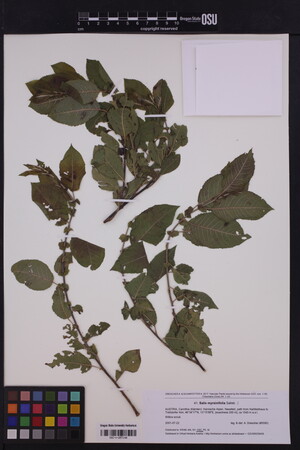Salix boothii
|
|
|
|
Family: Salicaceae
Barren-Ground Willow, more...Booth's Willow, blueberry willow
[Salix curtiflora auct. non Anderss., moreSalix lingulata Anderss., Salix myrsinites var. curtiflora , Salix myrtillifolia var. brachypoda Fernald, Salix myrtillifolia var. curtiflora auct. non (Anderss.) Bebb ex Rose, Salix myrtillifolia var. lingulata Ball, Salix novae-angliae var. myrtillifolia , Salix novae-angliae var. pseudocordata , Salix pseudocordata auct. non (Anderss.) Rydb., Salix pseudocordata var. aequalis (Anderss.) Ball ex Schneid., Salix pseudomyrsinites var. aequalis (Anderss.) Anderss. ex Ball] |
Plants 0.3-6 m. Stems: branches yellow-gray, yellow-brown, or red-brown, not glaucous, glabrous, pilose, or villous; branchlets yellow-brown, gray-brown, or red-brown, (not or weakly glaucous), glabrous, pilose, or moderately densely villous. Leaves: stipules foliaceous, apex acute, acuminate, or rounded; petiole convex to flat, or shallowly grooved adaxially, 3-17 mm, pilose, villous, or pubescent adaxially; largest medial blade (often amphistomatous), lorate, narrowly oblong, or narrowly to broadly elliptic, 26-102 × 8-30 mm, 2.5-3-5.2 times as long as wide, base convex, rounded, or subcordate, margins flat or slightly revolute, (thickened), entire or serrulate, apex acute or acuminate, abaxial surface not glaucous, glabrous, pilose, or moderately densely short-silky, hairs (white, sometimes also ferruginous), wavy, adaxial dull or slightly glossy, glabrous or moderately densely pilose; proximal blade margins entire, crenate, or serrulate; juvenile blade green, pilose to densely villous abaxially, hairs white, sometimes also ferruginous. Catkins flowering as or just before leaves emerge; staminate stout or subglobose, 7-37 × 5-12 mm, flowering branchlet 0.5-5.6 mm; pistillate densely or moderately densely flowered, stout, 12-62 × 7-17 mm, flowering branchlet 1-9 mm; floral bract brown, 0.7-2.1 mm, apex rounded or retuse, abaxially hairy throughout or proximally, hairs straight, wavy, or curly. Staminate flowers: adaxial nectary narrowly oblong, oblong, ovate, or flask-shaped, 0.6-1.5 mm; filaments distinct or connate ca. 1/2 their lengths, glabrous, hairy on proximal 1/2; anthers yellow or purple turning yellow, 0.5-0.8 mm. Pistillate flowers: adaxial nectary oblong, ovate, or flask-shaped, 0.3-0.8 mm, shorter than stipe; stipe 0.5-2.5 mm; ovary pyriform, glabrous, beak gradually to abruptly tapering to or slightly bulged below styles; ovules 10-18 per ovary; styles 0.3-1.4 mm; stigmas flat, abaxially non-papillate with rounded tip, or slenderly cylindrical, or 2 plump lobes, 0.2-0.26-0.48 mm. Capsules 2.5-6 mm. 2n = 76. Flowering early Apr-early Jul. Wet subalpine meadows, seepages, streams, lakeshores; 1500-3200 m; Alta., B.C., Sask.; Ariz., Calif., Colo., Idaho, Mont., Nev., Oreg., Utah, Wash., Wyo. Hybrids: Salix boothii forms natural hybrids with S. brachycarpa var. brachycarpa, S. eastwoodiae, S. glauca var. villosa, and S. wolfii. There are numerous intermediate specimens of S. boothii that suggest hybridization with S. arizonica, S. brachycarpa, S. eastwoodiae, S. lutea, or S. wolfii, but further study is needed. A DNA study of S. arizonica showed that a specimen from southwestern Utah previously identified as S. arizonica × S. wolfii probably was S. boothii × S. wolfii (J. T. Thompson et al. 2003). In Mountain Park, Alberta, and the Steens Mountains, Oregon, the putative hybrid Salix boothii × S. glauca var. villosa grew in thickets with both parents. Ovaries were sparsely hairy on the distal half or on the beak, leaves were glaucous abaxially, and floral bracts were mostly glabrous abaxially, but some with hairs proximally. One plant in fruit produced copious seed hairs but no seed.
Plant: shrub; to 6 m tall; branches gray- to red-brown, glabrous, villous to pilose; branchlets yellow- to gray-brown, glabrous, villous to pilose Leaves: petioles villous to pilose, 3-17 mm long; proximal leaves on vegetative or flowering branchlets gland-dotted or serrulate; young leaves pilose or villous; mature blade ligulate to narrowly oblong or narrowly elliptic to broadly so, 26-102 mm long, 8-30 mm wide, 2-5.2 times as long as wide, the lower surface non-glaucous, glabrous or pilose, the hairs white, or white and rust-colored, the upper surface shiny to highly glossy, pilose becoming glabrous, the base acute to rounded, rarely cordate, the margins flat or slightly revolute, entire, gland-dotted, or serrulate, with 2-12 teeth or glands per cm, the apex acute to abruptly short acuminate INFLORESCENCE: coetaneous or subprecocious; floral bracts tawny or dark brown, 0.7-2 mm long with wavy hairs, the apices rounded Flowers: STAMINATE FLOWERS in densely flowered catkins 20-25 mm long; flowering branchlets 0-5 mm long; filaments glabrous or hairy; nectary 1, slender or broad, 0.6-1.3 mm long. PISTILLATE FLOWERS in densely to moderately flowered catkins 10-70 mm long; flowering branchlets 0-15 mm long; ovaries glabrous; stigmas 0.2-0.48 mm long; styles 0.3-1 mm long; stipes 0.5-2.5 mm long; nectary broad, 0.3-0.8 mm long, shorter than stipe Fruit: lanceolate or ovate Misc: Subalpine; rare in wet meadows and along streams; 3000-3100 m (9000-9500 ft); May-Jun REFERENCES: Argus, George W. 1995. SalicaceaePart 2. Salix. J. Ariz. - Nev. Acad. Sci. 29(1): 39 |




































































































